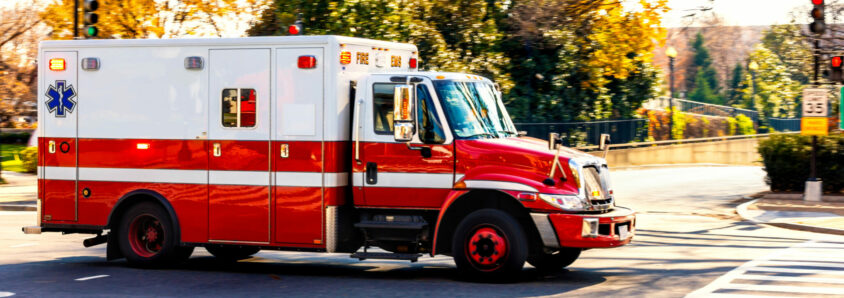Safety in medical transportation, whether by van, car, or ambulance, is essential.
Consequently, it is crucial to the health, well-being, and long-term performance of an ambulance driver or EMT that they implement proper safety measures. Of course, it’s also imperative that they implement safe driving tips for ambulances for their patients’ sake.
EMT drivers are looking for ways to improve emergency vehicle safety while on the road, so here are some safe driving tips for medical transport vehicles!
Safe Driving Tips for Medical Transport Vehicles
In the article below, we’re going to go over some safe driving tips for medical transport vehicles. These tips should always be adhered to when operating an ambulance or any other type of EMT vehicle.
Types of Medical Transport Vehicles
In the event of a medical situation, a person may be transported by medical transport vehicles. Here are some of the most common types of medical transport vehicles:
- ambulance
- air ambulance
- ambulance bus
- motorcycle ambulance
- non-transporting EMT vehicle
- water ambulance
With regard to a variety of automobiles used for commercial purposes, Prime can assist you in obtaining commercial auto insurance. Long-haul truckers, cab and limousine drivers, medical transport services, and other policyholders can work with us to find choices that are tailored to their particular needs. We also provide outstanding service!
Reduce Distractions
An EMT driver’s primary duty while operating an emergency vehicle is to drive it safely. They run the danger of being injured or killed if they are distracted in any way while operating a vehicle, including mentally, physically, or visually.
It should be highlighted that using a cell phone while driving is just as risky as holding it in a hand. Keep in mind that drivers who are using hands-free telephones have lower driving performance.
The danger of crashing is increased by a lot when reaching for a moving object, drinking, eating, and texting. All drivers should keep this in mind the next time they get behind the wheel and avoid all distractions!
Use a Spotter When Backing
Always be careful when backing up an emergency vehicle.
Mirrors should be maintained throughout the day and adjusted at the start of each shift. Only when the car is straight can the mirrors be adjusted correctly.
If there isn’t a spotter, the driver should choose the path of travel by scanning the area around the car for overhangs and obstacles. They should be aware of the vehicle’s height and keep an eye out for signage. It’s probably too close if it appears so. Turn in the direction of the driver when backing up. Naturally, having a spotter to assist the driver is preferable.
On the driver’s side of the car, the spotter should be 8 to 10 feet back. If the driver loses communication with the spotter, they should halt. It is unexpected that some services lack standardized hand gestures.
There are day and night variations of 11 different hand signals in the EVOC curriculum. Hand signals must be spelled out in policies and procedures, taught in orientation with proof of mastery, and monitored for compliance by supervisors.
Use the Three-Second Rule
The 3-second rule is an easy technique to make sure a driver is following other vehicles safely.
Choose a fixed object that is between the driver and the vehicle in front of them, like a building or a road sign. The driver may need to fall back and create extra distance between automobiles if they get to that same fixed position before they can count to three. If they do, they are driving too closely to the car in front of them.
Be Aware of Blind Spots
Like personal automobiles, trucks, and SUVs, medical transport vehicles have blind spots that cannot be avoided. To aid drivers with backing up, we always advise using a spotter.
Drivers should complete a “circle of safety,” which is walking all the way around the car to see any possible hazards before reversing if there is no spotter available.
Pay Close Attention At Intersections
Intersections present considerable risks in non-emergency situations in addition to the risks encountered during emergency operations.
Uncontrolled crossings are frequently found in suburban regions with little traffic. Stop for pedestrians, cars that are already in the intersection, and right-turning traffic. Slow down and halt when necessary for pedestrians and other cars at junctions with yield signs.
Increased situational awareness is necessary since other drivers’ actions at yield signs are unpredictable. Before moving forward, evaluate the volume of traffic in all directions. We must stop entirely at four-way stop signs and two-way controlled junctions.
It is unacceptable to glide past while applying the brakes. When it is safe and lawful to continue, stop in front of the limit line and only move forward after that. Specific consideration must be given to traffic signals.
To generate an 8–10 foot buffer when stopped at a red light, drivers should be able to see the rear tires of the car in front of them. A stale green light necessitates caution because a driver didn’t observe the change from red to green. Yellow traffic lights typically remain lit for one second for every ten miles per hour over the posted limit.
Keep the Phone Down
Did you know that phone usage while driving can increase collision risk by up to 8 times?
Driving while operating a phone is quite risky. In most cases, employees are not permitted to use a phone while operating a vehicle.
If drivers need to speak with a dispatcher on the radio or other emergency personnel, it is best to pull over if at all possible!
Enter and Exit the Vehicle Properly
When getting into or out of a car, maintaining three points of contact (two arms, one foot, or two feet, one arm) greatly reduces the danger of getting hurt. Because of the weather or even mud, drivers could easily slip, which could seriously damage the back, knees, and ankles.
It’s also wise for drivers to face the interior of the car when getting in or out to keep their center of gravity stable.
Use These Save Driving Tips for Ambulances and Stay Covered With Prime Insurance Company
If drivers remain aware of these safe driving tips for medical transport vehicles, they can arrive where they are needed in one piece. These safe driving tips for ambulances and other vehicles will also ensure the safety of all patients.
By offering creative liability solutions for niche risks, Prime Insurance Company goes beyond the bounds of traditional insurance providers. We take great pride in being an industry innovator in excess & surplus lines insurance, giving protection to many who would otherwise be compelled to forgo insurance or self-insure their risk.
For more on ambulance insurance, feel free to get in touch with us by either calling 800-257-5590 or emailing info@primeis.com!


